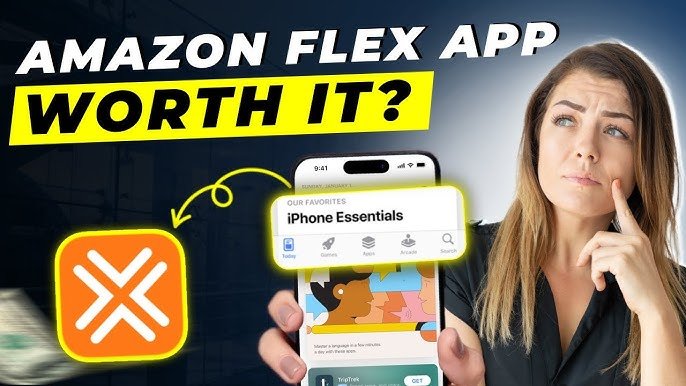
In recent years, the gig economy has exploded with opportunities for individuals to earn money on their own schedule. From rideshare driving to food delivery, flexible income streams have become increasingly popular. Among these options, Amazon Flex has emerged as a competitive way to earn by delivering packages for the e-commerce giant. But the question remains: Amazon Flex Worth In this article, we’ll take a deep dive into how it works, how much you can earn, and whether it’s the right choice for you.
What is Amazon Flex?

Amazon Flex is a delivery program that allows individuals to deliver Amazon packages using their own vehicles. Essentially, you become an independent contractor, picking up delivery “blocks” via the Amazon Flex app. Each block usually lasts 3 to 4 hours, and you are paid a fixed amount for completing deliveries within that time.
Deliveries may include:
- Amazon.com packages
- Prime Now or Amazon Fresh groceries
- Store orders from local retailers partnered with Amazon
How Does It Work?
To get started with Amazon Flex, you’ll need to:
- Download the Amazon Flex Worth app
- Register and pass a background check
- Select your service area
- Choose delivery blocks
Once approved, you can begin accepting delivery blocks based on your availability. You’ll go to a designated Amazon warehouse, load packages into your car, and use the app for navigation and delivery instructions.
Pros of Working for Amazon Flex
1. Flexible Schedule
As the name suggests, flexibility is one of the biggest advantages. You can choose when and how often you want to work. Whether you want to drive full-time or just on weekends, Amazon Flex offers control over your schedule.
2. Competitive Pay
Amazon advertises that drivers can earn between $18 to $25 per hour, depending on the region, time of day, and type of deliveries. While this can fluctuate, many drivers report average earnings of around $20/hour, which is relatively high in the gig economy space.
3. Independence
There’s no manager breathing down your neck. You’re on your own, completing routes independently without micromanagement. For self-starters, this kind of work environment can be appealing.
4. Simple Requirements
You don’t need a commercial driver’s license or special equipment. Most people with a valid driver’s license, a smartphone, and a reliable vehicle can start delivering in just a few days.
5. Fast Payments
Amazon Flex pays every Tuesday and Friday via direct deposit. The quick turnaround is great for those who need consistent and frequent cash flow.
Cons of Amazon Flex
1. Vehicle Wear and Tear
You’re using your own car, and that means additional mileage, fuel costs, and maintenance. Over time, this can significantly impact the resale value of your vehicle. Plus, you’re responsible for your own car insurance and any vehicle-related expenses.
2. No Benefits or Job Security
As an independent contractor, you’re not entitled to benefits like health insurance, retirement plans, or paid time off. If you get sick or your car breaks down, you’re out of luck (and income).
3. Limited Block Availability
Depending on your location and demand, getting delivery blocks can be competitive. Some drivers in busier cities report that blocks disappear within seconds of being posted. This can lead to frustration and inconsistent earnings.
4. Delivery Challenges
From hard-to-find addresses and apartment complexes to weather conditions and traffic delays, the delivery process can be physically and mentally taxing. You’re also responsible for undelivered packages if something goes wrong.
5. Tax Burden
As a 1099 contractor, you’ll need to handle your own taxes. This includes setting aside money for income tax and self-employment tax, and possibly hiring an accountant. You won’t get a W-2, and no taxes are withheld from your payments.
How Much Can You Realistically Make?
Let’s break it down:
- Average Pay: $18 to $25/hour
- Blocks per Week: Let’s say you do 20 hours/week
- Weekly Income: $360 – $500
- Monthly Income: $1,440 – $2,000
However, after factoring in fuel, maintenance, and taxes, your net income could be closer to $12 to $17/hour depending on your location and vehicle efficiency.
Tips to Maximize Your Earnings
- Be Fast and Efficient: The faster you finish your route, the better your hourly rate.
- Choose Busy Times: Demand is usually higher during weekends, holidays, and Prime Day.
- Track Expenses: Use apps or spreadsheets to log mileage, gas, and repairs for tax deductions.
- Optimize Routes: Learn shortcuts and traffic patterns in your area to save time.
- Use a Fuel-Efficient Vehicle: The less you spend on gas, the more you keep in your pocket.
Who Should Consider Amazon Flex?
Amazon Flex Worth is a great option if:
- You want a side gig to supplement your income.
- You’re between jobs and need temporary income.
- You enjoy driving and working independently.
- You have a reliable vehicle and don’t mind putting extra miles on it.

It might not be ideal if:
- You rely heavily on benefits or job security.
- Your car is older or not fuel-efficient.
- You live in a rural area with few delivery opportunities.
Final Verdict: Is Amazon Flex Worth It?
Yes, Amazon Flex can be worth it—for the right person. If you’re looking for flexibility, decent pay, and autonomy, it’s a solid side hustle or part-time income stream. However, it’s not without its challenges, especially in terms of vehicle costs and lack of benefits.
For those who value a traditional job structure with stability, Amazon Flex Worth may not be the best fit. But if you’re self-motivated and comfortable managing your own expenses and taxes, it could be a worthwhile gig.
In short: Amazon Flex is not a get-rich-quick scheme, but it can be a valuable and flexible way to earn money—especially if you play it smart.






